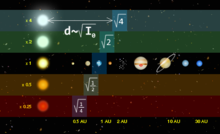Zon boleh didiami
Dalam astronomi, Zon boleh didiami (juga dikenali sebagai zon boleh dihuni atau zon kehidupan; singkatannya ialah HZ) adalah jarak dari bintang di mana planet serupa dengan Bumi boleh mengandungi air cecair di atas permukaannya[1] dan kehidupan serupad dengan Bumi. Zon kehidupan adalah persilangan dua kawasan yang kedua-duanya mesti berpihak kepada kehidupan: satu dalam sistem planet, dan lain di dalam galaksi. Planet dan bulan-bulan di kawasan-kawasan ini adalah calon-calon likeliest untuk menjadi didiami dan dengan itu mampu melahirkan kehidupan ruang angkasa yang serupa dengan kita sendiri.

Lihat juga
suntingRujukan
suntingPautan luar
sunting- The Habitable Zone Gallery
- The Encyclopedia of Astrobiology, Astronomy and Spaceflight (Habitable Zone)
- The Encyclopedia of Astrobiology, Astronomy and Spaceflight (Galactic Habitable Zone)
- "Stars and Habitable Planets" at SolStation
- Nikos Prantzos (2006). "On the Galactic Habitable Zone". Space Science Reviews. 135: 313–322. arXiv:astro-ph/0612316. Bibcode:2008SSRv..135..313P. doi:10.1007/s11214-007-9236-9.
- Swiss Scientist: Search for Life Next
- Stephen H. Dole and Isaac Asimov's Planets for Man Defining what environment is habitable for people. (copyright 1964)
- NASA: The Goldilocks Zone Diarkibkan 2009-07-14 di Wayback Machine
- Interstellar Real Estate: Location, Location, Location – Defining the Habitable Zone
- Definition of "goldilocks" connoting "moderate characteristics" and examples referring to planets dating to 1935.
- "Exoplanet Habitable Zone Candidates: exoplanets in terms of their historical chances for residing in the habitable zone". www.planetarybiology.com.
- "Exoplanets in relation to host star's current habitable zone". www.planetarybiology.com.
- "exoExplorer: a free Windows application for visualizing exoplanet environments in 3D". www.planetarybiology.com.
- "Calculating the location of habitable zone at zero age main sequence (ZAMS)" (PDF). www.planetarybiology.com. Diarkibkan daripada yang asal (PDF) pada 2008-07-04. Dicapai pada 2008-11-10.
- Shiga, David (2008-11-19). "Why the universe may be teeming with aliens". Space. NewScientist. Dicapai pada 2009-11-19.
- Seager, Sara; Ford; Turner (2002). "Characterizing Earth-like planets with Terrestrial Planet Finder". arXiv:astro-ph/0212551 [astro-ph].
- "Kepler Mission to Hunt for Earth-like Planets". Science@NASA. February 20, 2009. Diarkibkan daripada yang asal pada 2010-03-16. Dicapai pada 2010-03-31.
- Simmonsa; dll. "The New Worlds Observer: a mission for high-resolution spectroscopy of extra-solar terrestrial planets" (PDF). New Worlds. Dicapai pada 2010-03-31. Explicit use of et al. in:
|author=(bantuan) - Cockell; dll. (2009). "Darwin—an experimental astronomy mission to search for extrasolar planets" (PDF). Springerlink. m/s. 435–461. doi:10.1007/s10686-008-9121-x. Explicit use of et al. in:
|author=(bantuan)[pautan mati kekal] - Atkinson, Nancy (March 19, 2009). "JWST Will Provide Capability to Search for Biomarkers on Earth-like Worlds". Universe Today. Diarkibkan daripada yang asal pada 2009-03-27. Dicapai pada 2010-03-31.
- "PlanetQuest: Mission". SIM PlanetQuest. Diarkibkan daripada yang asal pada 2010-12-19. Dicapai pada 2010-03-31.